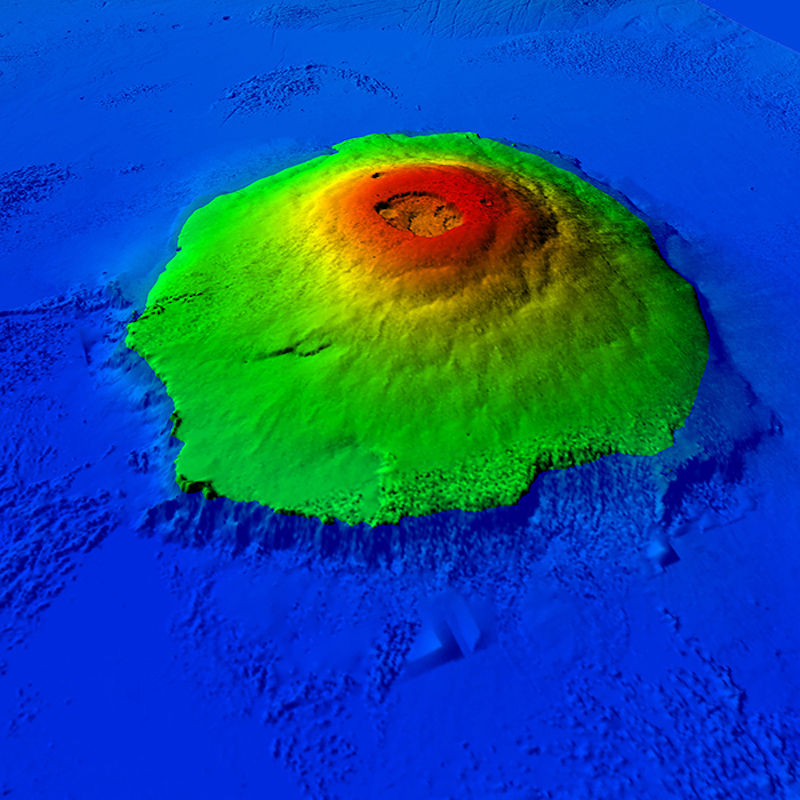
Olympus Mons, on the planet Mars, is the biggest volcano in our solar system. It’s bigger than the U.S. state of Arizona. And it towers about 14 miles (22 km) above the surrounding Martian desert. It’s a spectacular sight from Mars orbit. But now imagine this giant Mars volcano as an island surrounded by water. On July 25, 2023, researchers at the French National Centre for Scientific Research (CNRS) and Université Paris-Saclay in France announced the results of their new study suggesting that Olympus Mons was once a volcanic island, surrounded by a deep sea.
On July 24, the researchers published their peer-reviewed findings in the journal Earth and Planetary Science Letters.
Largest volcano in the solar system
Olympus Mons isn’t just big. It’s massive, and far beyond the size of any volcano on Earth. It easily dwarfs Earth’s biggest volcano, Mauna Loa in Hawaii (which is 75 miles/ 120 km across and 5.6 miles/ 9 km tall).
In contrast, Olympus Mons is about 374 miles (600 km) wide wide at its widest point. And it stands about 14 miles (22 km) above the surrounding plains (2 1/2 times the height of Everest).
The caldera at its summit is 53 miles (85 km) in diameter!
Olympus Mons is a shield volcano, and scientists said it was likely built up from eruptions of fairly fluid (low viscosity) basaltic lava. Shield volcanoes have a lower profile – wider than they are tall – than other types of volcanoes.
Was Olympus Mons a volcanic island?
Evidence has been growing in recent years for an ancient ocean in the northern hemisphere of Mars. Scientists have even found signs of former shorelines and marine sediments. Now, it seems that an ocean may have surrounded Olympus Mons, meaning that it was actually a volcanic island a few billion years ago.
The new study showed that Olympus Mons shares morphological similarities with many active volcanic islands on Earth. These include ones like Pico Island in Portugal, Fogo Island in Canada and Hawaii in the United States. Geoscientist Anthony Hildenbrand at CNRS, who led the research team, stated:
Here we show that the Olympus Mons giant volcano shares morphological similarities with active volcanic islands on Earth, where major constructional slope breaks systematically occur at the sea-air transition in response to sharp lava viscosity contrasts.
We propose that the upper rim of the 6-kilometer [3.7-mi] high concentric main escarpment surrounding Olympus Mons most likely formed by lava flowing into liquid water when the edifice was an active volcanic island during the late Noachian–early Hesperian.

Mystery escarpment provides clues
One of the biggest clues about the history of Olympus Mons is at the base of the volcano. The volcano doesn’t just slope gently into the surrounding terrain. Instead, for much of the circumference, the base is a steep cliff, or escarpment. This escarpment is about 4 miles (6.5 km) tall. That abrupt change in the shape of the volcano has long puzzled planetary scientists.
The researchers found that this escarpment is similar to those on volcanic islands on Earth. These cliffs form when lava flows down the sides of the volcanoes and hits the surrounding ocean water. This creates a change in the viscosity of the lava. The paper said:
This leads us to propose that Olympus Mons was a former volcanic island surrounded by liquid water.
The average height of the main escarpments suggests a 6-km-thick [3.7-mi-thick] column of liquid water initially surrounding the inferred volcanic island. This is more than the average depth of oceans on Earth, and twice the plausible depth for an early Martian ocean [about 3.8 billion years ago] … Nevertheless, the escarpment height is not inconsistent with a globally shallow ocean.
But why the disparity with the estimated ocean depth from previous studies? Basically, the scientists said, there were massive plumes of lava below where the volcanoes now sit. Those plumes created the Tharsis Bulge that this group of volcanoes sits on. However, the same plumes also deformed the planet’s crust underneath the ocean so much that it actually shifted the ocean itself.
The top of the escarpment would have been the sea level of the now long-gone ocean. Scientists have also dated the last lava flows to about 3 to 3.7 billion years ago, so the ocean would have been present at that time.
Similar volcano hundreds of miles away from Olympus Mons
The researchers also found that another volcano, Alba Mons, features similar characteristics to Olympus Mons. Alba Mons is 932 miles (1,500 km) away, with vast lowlands separating it from Olympus Mons. This could mean that the ocean filled in the lowlands and surrounded both volcanoes. This supports earlier findings that the ancient ocean once covered much of the northern hemisphere of Mars, in the lowlands. As the paper explains:
Conspicuous slope breaks at the top of the main basal escarpment surrounding Olympus Mons are here interpreted as paleo-shorelines around a former volcanic island. Similar features at Alba Mons further support the existence of an early ocean occupying the northern plains of Mars along the northwestern edge of the Tharsis region.
Interestingly, a previous study from 2018 also suggested a link between the ancient ocean on Mars and the formation of the Tharsis volcano system, of which Olympus Mons is a part.
Bottom line: Scientists in France have found new evidence that the largest volcano on Mars, Olympus Mons, was once a volcanic island surrounded by an ancient northern ocean.
Source: A giant volcanic island in an early Martian Ocean?











